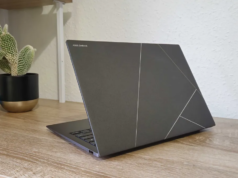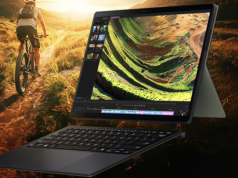The ASUS Vivobook S15 OLED is a notable addition to ASUS’s Vivobook lineup, but this model sets itself apart with its cutting-edge internal hardware—namely the Snapdragon X Elite SoC. While ARM processors have been making their way into the realm of Windows laptops for some time, the Snapdragon X Elite represents something distinct, with the potential to compete with Apple’s M-series chipsets.
The Snapdragon X Elite promises to strike a balance between performance and efficiency, setting the Vivobook S15 apart from the crowd. Equipped with AI capabilities, this device boasts Copilot+ PC certification, a rare feature among Windows laptops. In this review, we’ll explore the impact of the Snapdragon X Elite on the Vivobook S15 OLED and whether it’s a worthwhile investment.

Performance: The ARM Factor
The most striking feature of the ASUS ASUS Vivobook S15 OLED is its performance, powered by the Qualcomm Oryon Snapdragon X Elite, an ARM-based processor that stands in contrast to traditional x86 chips. While this shift opens up new avenues for innovation, it also introduces some growing pains, particularly in app compatibility.

Since the laptop uses an ARM-based chipset, several apps rely on emulation to run, and this can lead to compatibility issues. For instance, certain programs such as QuickShare were entirely non-functional, while others like Adobe Premiere could only run through emulation. This limitation may improve over time as ARM compatibility expands, but as of now, users should be prepared for a less-than-seamless experience with some apps.
Key Specifications
- Processor: Qualcomm Oryon Snapdragon X (12C/12T), up to 3.42 GHz
- Graphics: Qualcomm Adreno 311, with 8 GB shared memory
- AI Engine: 45 TOPS Qualcomm Hexagon NPU
- RAM: 16 GB LPDDR5X (soldered)
- Storage: 1 TB Micron 2450 SSD (M.2 2280)
- Wireless: Wi-Fi 7 (Qualcomm FastConnect 7800)


Benchmark Performance
In terms of synthetic benchmarks, the ASUS Vivobook S15 OLED delivers solid but not groundbreaking performance. On Geekbench 6, it scored 1,745 for single-core and 8,828 for multi-core performance while running on battery power. When plugged in, those numbers improved to 2,451 (single-core) and 14,250 (multi-core).

GPU performance, as tested on Geekbench 6’s OpenCL and Vulkan benchmarks, showed scores of 19,014 and 22,933 on battery, with minor improvements when plugged in. 3D Mark benchmarks similarly placed the device in a respectable position. On the Wild Life Extreme test, the laptop scored 5,947 on battery and 6,362 when plugged in. Other benchmarks like Solar Bay and Steel Nomad returned scores of 10,262 and 488 respectively, when plugged in.

For storage performance, the 3D Mark Storage Test yielded a score of 1,266, while CrystalMark tests revealed sequential read speeds of 4,989 MB/s and write speeds of 3,233 MB/s. Random read and write speeds came in at 274 MB/s and 437 MB/s, respectively.
Gaming Performance
While not marketed as a gaming machine, the ASUS Vivobook S15 OLED performs reasonably well for casual gaming, though it’s far from being a powerhouse in this department. However, due to the ARM architecture, many popular titles are incompatible.

Some performance stats for compatible games:
- The Witcher 3: Wild Hunt: 37 FPS on Low at 1080p
- GTA 5: 39 FPS on High settings
- Shadow of the Tomb Raider: 38 FPS at 1080p, but improves to 42 FPS at 720p

The fans kick in frequently during gaming sessions, but they aren’t particularly loud. The overall experience is adequate, but heavy gamers will likely want something more robust.
Design and Build Quality

The ASUS Vivobook S15 OLED stands out with its aluminum chassis, lending it a premium feel. Despite its sturdy build, the laptop is surprisingly lightweight, weighing just 1.42 kg.

It measures 352.6 x 226.9 x 15.9 mm, giving it a slim, portable profile. The 15.6-inch display takes up most of the lid, and the laptop opens smoothly with just one hand.

The design incorporates a sleek tapered profile and features a sturdy hinge capable of rotating 180 degrees. The chassis shows little to no flex, which speaks to its build quality. A minimalistic ASUS Vivobook S15 OLED logo on the back adds a subtle design touch.

Ports
In terms of connectivity, the ASUS Vivobook S15 OLED offers a generous array of ports:

- Left Side: HDMI 2.1, 2x Thunderbolt 4, 1x microSD slot, and a 3.5mm audio jack.
- Right Side: 2x USB 3.2 Gen 1 Type-A ports, battery, and power indicators.

The bottom of the laptop houses dual stereo speakers and air intake vents, with an exhaust vent positioned below the display. The laptop also includes a 1080p webcam with a physical shutter for privacy, though IR scanning for Windows Hello did not function as expected on our test unit.
Keyboard and Trackpad
The full-sized keyboard includes a numpad, with a 1.5 mm key travel that makes for a comfortable typing experience.

However, the power button is integrated into the keyboard, making accidental presses possible. ASUS has also replaced the right Control key with a Copilot key, which may be useful for frequent Copilot users but could be an unnecessary change for others.

The trackpad is spacious and responsive, featuring built-in gestures that allow for brightness and volume adjustment by swiping on specific edges. These gestures work in addition to the standard Windows gestures, providing excellent control.
Display
The 15.6-inch OLED display is undoubtedly one of the highlights of this laptop. It boasts a 3K resolution (2880 x 1620) with a pixel density of 212 PPI. The display supports a 120 Hz refresh rate and achieves a peak brightness of 600 nits. While this brightness level is more than sufficient for indoor use, it struggles a bit under direct sunlight.

Color accuracy is impressive with 100% DCI-P3 coverage, ensuring vivid colors and deep blacks. The screen also supports HDR and is flicker-free, making it a joy to use for watching content or even for gaming. The option to toggle between 60 Hz and 120 Hz is available, but given the battery efficiency, sticking with 120 Hz is recommended for smoother visuals.

Battery Life and Charging
The ASUS Vivobook S15 OLED packs a 70Wh battery, providing excellent battery life. ASUS claims up to 18 hours, but in real-world conditions, it lasted between 10 and 13 hours. The standby battery drain is minimal, dropping only 1-2% when idle, and the laptop easily stretches across multiple days of moderate use.

Charging takes about two hours with the included 90W adapter, but the charging setup feels outdated. A USB-C to USB-C cable would have been a more modern and versatile solution, though both USB-C ports support power delivery, allowing for alternative charging options.

Software and Features
The ASUS Vivobook S15 OLED runs on Windows 11, providing a smooth software experience. The MyASUS app offers various customization options, allowing users to adjust performance settings, calibrate the display, and monitor system resources. It also includes features like Smart Connect for enhanced Wi-Fi and Trackpad gestures for added convenience.

Verdict: Is It Worth Buying?
At a price of $1,499 USD, the ASUS Vivobook S15 OLED offers an intriguing balance of innovative hardware and minor compromises. The Snapdragon X Elite processor is a bold step forward for Windows laptops, though the ARM app compatibility issues may still be a stumbling block for some.

However, for users willing to embrace this cutting-edge technology, the design, battery life, and display quality make it a compelling choice. Early adopters with an eye on the future of ARM computing on Windows will find this laptop an exciting option to consider.
Overall Ratings:
- Performance and Gaming: 7/10
- Design and Build: 8.5/10
- Keyboard and Trackpad: 8/10
- Display: 9/10
- Battery Life and Charging: 9.5/10
- Software: 8/10
- Speakers and Webcam: 7.5/10






